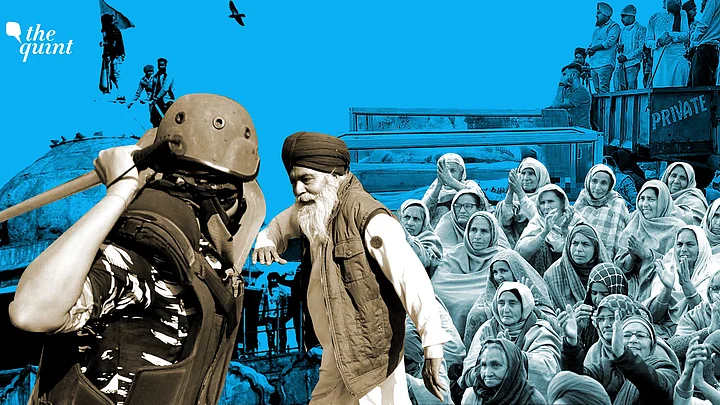They were subjected to a vicious fake news campaign, were vilified by media, called 'terrorists', 'anti-nationals' and 'khalistanis', were beaten with sticks, rods and water cannons for demanding their rights and were even allegedly mowed down by a speeding car belonging to a sitting cabinet minister's son.
On 19 November, at 9 am, when Prime Minister Narendra Modi announced that his government will roll back the three contentious farm laws, his decision came at a price — one paid by the agitating farmers and their families.
Here's a recap of what transpired in this yearlong struggle and the actual cost of farmers' protest:
'Dilli Chalo': When Farmers Reached The National Capital
After the three farm laws were passed in the Parliament of India in September 2020, protests broke out in parts of Punjab and Haryana where farmer unions and their representatives demanded that the laws be immediately repealed.
Two months of protests later, farmers decided to march to the national capital to further their protests, but not without facing water cannons, tear gas and used sticks, batons and barricades.
Braving this, several groups of farmers were able to enter Delhi on 27 November, following which they went on to camp at the Singhu Border, Tikri Border, Kalindi Kunj Border, Chilla Border and several other points of entry to the national capital.
Out of these, the Singhu and the Tikri border went on to become the epicentres of the protests.
'Anti-Nationals', 'Khalistanis', 'Terrorists': How Narratives Were Built Using Social and Mainstream Media
The trouble for protesting farmers had only started when they reached Delhi in November. Slowly, they were vilified by the national media and a coordinated misinformation campaign played out on social media.
Farmers were called "anti-national elements", branded as "terrorists" and "khalistanis" and morphed images were used to discredit the protest sites.
In an analysis by The Quint, it was found that most of this misinformation and narrative building was done by people from verified quarters such as mainstream media, political parties, and leaders.
From Prime Minister Modi himself calling the protesters 'aandolanjeevis' to party's social media head Amit Malviya and spokesperson Sambit Patra regularly sharing misinformation targeting the protesters and celebrities like Kangana Ranaut hinting that protests were "paid", protesters were relentlessly and aggressively targeted.
The Red Fort Violence, Its Aftermath & 'Toolkit Case'
A major turning point in the movement came on 26 January 2020 — during the Republic Day Kisan Parade. As thousands of farmers riding tractors, horses and on foot drove into Delhi, they were barred from entering the central part of the city where Republic Day parade was taking place.
The march which started from Singhu and Tikri Border turned violent after clashes broke out between Delhi Police and some protesters who deviated from the "approved" path and marched towards the Red Fort. Several protesters then entered the fort and hoisted the Sikh religious flag on the flagpole.
A 26-year-old farmer Navneet Singh also died near ITO after the tractor he was riding overturned.
After the violence, there was a massive sentiment against the protesters and just when it appeared that the protests are winding down, an emotional address to the media by Bharatiya Kisan Union (BKU) spokesperson Rakesh Tikait at the Ghazipur Border turned things around.
Tikait's address, which came on the heels of local administration in Ghaziabad giving an ultimatum to the farmers to end their protests, led to hordes of farmers from Uttar Pradesh joining the protesters and reviving the movement.
Soon after in February, the protests were declared to be a part of an 'international conspiracy' against India. In fact, 21-year-old climate activist Disha Ravi was sentenced to 5 days of police remand in what later came to be known as the ‘protest-toolkit case’.
It was alleged that Ravi hatched a ‘criminal conspiracy along with Swedish environmental activist Greta Thunberg and various others to prepare a toolkit’ on the farmers’ protests.
Death By Suicide(?)
Several cases of death by suicide and due to medical reasons have been documented at the protests sites. According to a conservative estimate by the Samyukta Kisan Morcha (SKM), a farmer body spearheading the protests, more than 600 farmers have died during the protests.
On 18 December 2020, Gurlabh Singh, a 22-year-old farmer allegedly consumed poison and died after he went back home to Bhatinda in Punjab after sitting at the morcha for two months. Earlier on 16 December, a priest shot himself dead at the Singhu Border leaving behind a suicide note in which he mentioned that he could not "bear to see the pain of the farmers".
More recently, in January 2021, Amrinder Singh, a 40-year-old farmer, had killed himself by swallowing Aluminium phosphide tablets at the Singhu border.
But protesting farmers didn't just die by suicide or due to medical and health issues, in a shocking incident four farmers were killed in Tikunia in Uttar Pradesh's Lakhimpur Kheri district after they were run over by a car allegedly being driven by Ashish Mishra, son of of Union Minister of State Ajay Mishra.
Total eight people died in the violence including a 28-year-old journalist, Raman Kashyap.
With Assembly elections in Uttar Pradesh and Punjab in sight, the decision to repeal the farm laws might like a calculated move by the central government, with some even calling it a "gift" for the farmers. However, after one full year of fighting slander, fake news and state machinery, farmers have had to pay for this with more than 600 lives.
